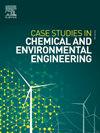Investigating the effect of electric field amplitude on the thermal behavior of paraffin/Cu nanostructure in a tube containing non-connected rotating ribs using molecular dynamics simulation
Q1 Environmental Science
Case Studies in Chemical and Environmental Engineering
Pub Date : 2025-01-27
DOI:10.1016/j.cscee.2025.101115
引用次数: 0
Abstract
This research investigates the impact of varying external electric field amplitudes on the atomic and thermal properties of a paraffin/copper composite in a tube with non-interconnected rotating ribs, using molecular dynamics simulation as the primary analytical tool. To ensure model accuracy, a preliminary equilibration phase is conducted for 10 ns under controlled conditions. This stabilized the temperature at 300 K and established a consistent total energy of 1.450 kcal/mol. After equilibration, an analysis examined how varying external electric field amplitudes influenced the thermal properties of composite with 7 % copper concentration. The results indicate that as external electric field amplitudes increased from 0.01 to 0.05 V/m, various parameters of the simulated atomic sample show notable variations. Specifically, maximum density decreased from 0.0848 to 0.0836 atom/ų, while maximum velocity increased from 0.00496 to 0.00519 atom/Å. Additionally, maximum temperature increases from 770 to 789 K, and heat flux increases from 5.59 to 5.71 W/m2. Thermal conductivity increases from 0.72 to 0.78 W/m·K, and charging time decreases from 6.17 to 5.99 ns. When external electric field amplitude increases from 0.01 to 0.03 V/m, discharge time decreases from 7.16 to 7.05 ns; however, at 0.05 V/m, discharge time slightly increases to 7.09 ns. These findings have practical implications for optimizing materials in thermal management and energy storage systems by tailoring electric field conditions to enhance performance.
采用分子动力学模拟方法研究了电场振幅对石蜡/铜纳米结构在非连接旋转肋管中的热行为的影响
本研究采用分子动力学模拟作为主要分析工具,研究了不同外电场振幅对石蜡/铜复合材料在非互连旋转肋管中的原子性能和热性能的影响。为了保证模型的准确性,在控制条件下进行了10 ns的初步平衡阶段。这将温度稳定在300 K,并建立了一致的总能量为1.450千卡/摩尔。平衡后,分析了不同的外电场振幅如何影响7%铜浓度下复合材料的热性能。结果表明,随着外电场振幅从0.01 V/m增加到0.05 V/m,模拟原子样品的各项参数有显著变化。其中,最大密度从0.0848原子/ų下降到0.0836原子/ų,而最大速度从0.00496原子/Å增加到0.00519原子/Å。最高温度从770 K增加到789 K,热流密度从5.59 W/m2增加到5.71 W/m2。导热系数从0.72增加到0.78 W/m·K,充电时间从6.17 ns减少到5.99 ns。当外加电场幅值从0.01 V/m增加到0.03 V/m时,放电时间从7.16 ns减少到7.05 ns;而在0.05 V/m时,放电时间略有增加,达到7.09 ns。这些发现对于通过调整电场条件来优化热管理和储能系统中的材料以提高性能具有实际意义。
本文章由计算机程序翻译,如有差异,请以英文原文为准。
求助全文
约1分钟内获得全文
求助全文
来源期刊

Case Studies in Chemical and Environmental Engineering
Engineering-Engineering (miscellaneous)
CiteScore
9.20
自引率
0.00%
发文量
103
审稿时长
40 days
 求助内容:
求助内容: 应助结果提醒方式:
应助结果提醒方式:


